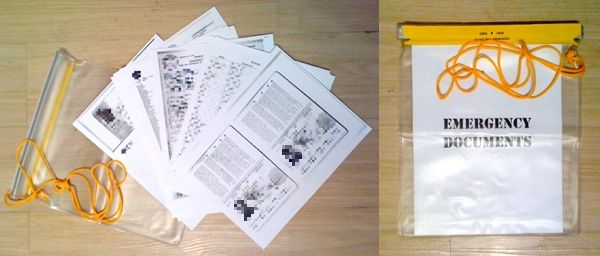If your home is severely damaged after an earthquake or waterlogged from a flood, all your identity, insurance and asset documents could be lost. Even if your home stays intact, there may not have time to gather these should you have to evacuate for any reason.
One often overlooked item of a emergency kit or bug-out-bag is a
document pack. This is where you can keep copies of all your important documents, along with contact numbers and photographs of your family. Remember to place these in a waterproof bag. (If possible, they should also be in a fireproof bag but unfortunately, I have not seen these for sale in the Philippines. If anyone knows where these can be purchased, please
let me know.)

Emergency document pack containing important documents
Example contents for your emergency document pack include:
- Passports and ID cards
- Medical history, immunization records and list of medications
- Photographs of each family member with names
- Birth, baptismal and marriage certificates
- Social Security and TIN numbers
- Property deeds
- Insurance documents
- Bank account, financial details and investments
- Wills and trusts
- Emergency plan
- Address and telephone number listing
- City map and route to your bug-out location
- Cash in large and small notes
Remember that this pack will contain confidential information. If lost, these could be used for identity theft or fraud. One way to protect against this is to write certain things in code. For example, you can include dummy numbers to obscure your real bank account number or code words for important locations.
This way, even if Manila is faced with a complete
disaster or catastrophe, you can at least make it easier to rebuild your life. You will have less difficulty proving who you are to the authorities and you'll have a record of your assets.
Continue Reading

 Article by Pinoy Prepper, Emergency Research Center
"Lamang ang Handa sa Hindi!"
Prepper Definition:
Article by Pinoy Prepper, Emergency Research Center
"Lamang ang Handa sa Hindi!"
Prepper Definition:
 You can read her article at Bubu and mama: Baby Bug-Out Bag Continue Reading
You can read her article at Bubu and mama: Baby Bug-Out Bag Continue Reading